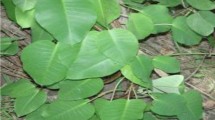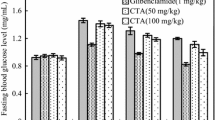Abstract
In the present study oxidative stress, DNA damage in streptozotocin induced diabetic rats and its repair after treating with ethanolic extract of Nigella sativa seed were evaluated via comet assay and estimation of SOD and TBARS. Blood lymphocytes of Streptozotocin (60 mg/kg BW) induced diabetic rats showed significant increase (p < 0.05) in DNA damage as evidenced by comet tail length, due to the formation of reactive oxygen species (ROS) leading to genotoxicity. Feeding rats with ethanolic extract of N. sativa seed (500 mg/kg BW) significantly (p < 0.05) improved the level of SOD and TBARS and decreased the comet tail length and percentage of comet cells, indicating the antioxidative and genoprotective potentiality of Nigella sativa seed.












Similar content being viewed by others
References
Akbarzadeh A, Norouzian D, Mehrabi MR, Jamshidi Sh, Farhangi A, Allah Verdi A, Mofidian SMA, Lame Rad B (2007) Induction of diabetes by Streptozotocin in rats. Indian J Clin Biochem 22(2):60–64
Al Wafai RJ (2013) Nigella sativa and thymoquinone suppress cyclooxygenase-2 and oxidative stress in pancreatic tissue of streptozotocin-induced diabetic rats. Pancreas 42(5):841–849
Alam P, Yusufoglu H, Alam A (2013) HPTLC densitometric method for analysis of thymoquinone in Nigella sativa extracts and marketed formulations. Asian Pac J Trop Dis 3(6):467–471
Ali BH, Blunden G (2003) Pharmacological and toxicological properties of Nigella sativa. Phytother Res 17:299–305
Babazadeh B, Sadeghnia HR, Kapurchal ES, Nasri S, Najaran ZT (2012) Protective effect of Nigella sativa and thymoquinone on serum/glucose deprivation-induced DNA damage in PC12 cells. Avicenna J Phytomed 2(3):125–132
Badary OA (1999) Thymoquinone attenuates ifosfamide-induced Fanconisyndromein rats and enhances its antitumor activity in mice. J Ethnopharmacol 67:135–142
Badary OA, Taha RA, Gamal el-Din AM, Abdel-Wahab MH (2003) Thymoquinone Is a potent superoxide anion scavenger. Drug Chemical Toxicol 26:87–98
Biswas M, Kar B, Bhattacharya S, Kumar RB, Ghosh AK, Haldar PK (2011) Antihyperglycemic activity and antioxidant role of Terminalia arjuna leaf in streptozotocin-induced diabetic rats. Pharm Biol 49(4):335–340
Burits M, Bucar F (2000) Antioxidant activity of Nigella sativa essential oil. Phytother Res 14:323–328
Damasceno DC, Netto AO, Iessi IL, Gallego FQ, Corvino SB, Dallaqua B, Sinzato YK, Bueno A, Calderon IPM, Rudge MVC (2014) Streptozotocin-induced diabetes models: pathophysiological mechanisms and fetal outcomes. Biomed Res Int 2014(2014):819065
Datta NJ, Namasivayam A (2003) In vitro effect of methanol on folate-deficient rat hepatocytes. Drug Alcohol Depend 71:87–91
David MN (1996) The pathophysiology of diabetic complications. Ann Intern Med 124:86–89
El-Tantawy WH, Temraz A (2018) Management of diabetes using herbal extracts: review. Arch Physiol Biochem 124(5):383–389
Erejuwa OO, Sulaiman SA, Wahab MSA, Sirajudeen KNS, Salzihan M, Salleh M, Gurtu S (2010) Antioxidant protective effect of Glibenclamide and Metformin in combination with honey in pancreas of streptozotocin-induced diabetic Rats. Int J Mol Sci 11(5):2056–2066
Fabricant DS, Farnsworth NR (2001) The value of the plants used in traditional medicine for drug discovery. Environ Health Perspect 109:69–75
Fiorentino TV, Prioletta A, Zuo P, Folli F (2013) Hyperglycemia-induced oxidative stress and its role in diabetes mellitus related cardiovascular diseases. Curr Pharm Des 19(32):5695–5703
Gilhotra N, Dhingra D (2011) Thymoquinone produced antianxiety-like effects in mice through modulation of GABA and NO levels. Pharmacol Rep 63:660–669
Hossein H, Siavash P, Marjan NA, Sadeghnia Hamid R, Toktam Z (2007) Effect of thymoquinone and Nigella sativa seeds oil on lipid peroxidation level during global cerebral ischemia-reperfusion injury in rat hippocampus. Phytomedicine 14:621–627
Houghton PJ, Zarka R, De las Heras B, Hoult JR (1995) Fixed oil of Nigella sativa and derived thymoquinone inhibit eicosanoid generation in leukocytes and membrane lipid peroxidation. Planta Med 61:33–36
Ilhan A, Gurel A, Armutcu F, Kamisli S, Iraz M (2005) Antiepileptogenic and antioxidant effects of Nigella sativa oil against pentylenetetrazol-induced kindling in mice. Neuropharmacology 49:456–464
Isabelle M, Michel P, Dominique L (2005) Antioxidant strategies in the treatment of stroke. Free Radical Biol Med 39:429–443
Janusz B, Michal A, Renata K, Katarzyna W, Marek Z et al (2004) DNA damage and repair in type 2 diabetes mellitus. Mutat Res 554:297–304
Kaatabi H, Bamosa AO, Badar A, Al-Elq A, Abou-Hozaifa B, Lebda F, Al-Khadra A, Al-Almaie S (2015) Nigella sativa improves glycemic control and ameliorates oxidative stress in patients with type 2 Diabetes Mellitus: placebo controlled participant blinded clinical trial. PLoS ONE 10(2):e0113486
Kaneto NY, Kawamori D, Miyatsuka T, Matsuoka TA, Matsuhisa M, Yamasaki Y (2006) Role of oxidative stress, endoplasmic reticulum stress, and c-Jun N-terminal kinase in pancreatic beta-cell dysfunction and insulin resistance. Int J Biochem Cell Biol 38(5–6):782–793
Kanter M (2008) Effects of Nigella sativa and its major constituent, Thymoquinone on sciatic nerves in experimental diabetic neuropathy. Neurochem Res 33:87–96
Kanter M, Coskun O, Kalayci M, Buyukbas S, Cagavi F (2006) Neuroprotective effects of Nigella sativa on experimental spinal cord injury in rats. Hum Exp Toxicol 25:127–133
Kassie F, Parzefall W, Knasmüller S (2000) Single cell gel electrophoresis assay: a new technique for human biomonitoring studies. Mutat Res 463:13–31
Kedziora-Kornatowska K, Szewczyk-Golec K, Kozakiewicz M, Pawluk H, Czuczejko J, Kornatowski T et al (2009) Melatonin improves oxidative stress parameters measured in the blood of elderly type 2 diabetic patients. J Pineal Res 46:333–337
Khader M, Bresgen N, Eckl PM (2010) Antimutagenic effects of ethanolic extracts from selected Palestinian medicinal plants. Journal of Ethnopharmacy 127(2):319–324
Kumar GPS, Arulselvan P, Kumar SD, Subrimaniam PS (2006) Antidiabetic activity of fruits of Terminalia chebulaon STZ induced diabetic rats. J Health Sci 52:283–291
Lenzen S (2008) The mechanisms of alloxan- and streptozotocin-induced diabetes. Diabetologia 5:216–226
Marklund S, Marklund G (1974) Involvement of the superoxide anion radical in the autoxidation of pyrogallol and a convenient assay for superoxide dismutase. Eur J Biochem 47(3):469–474
Mousavi SH, Tayarani-Najaran Z, Asghari M, Sadeghnia HR (2010) Protective effect of Nigella sativa extract and Thymoquinone on serum/glucose deprivation-induced PC12 cells death. Cell Mol Neuro biol 30:591–598
Nehar S, Kumari M (2013) Ameliorating Effect of Nigella sativa oil in thioacetamide-induced liver cirrhosis in albino rats. Indian J Pharm Educ Res 47(2):135–139
Nehar S, Rani P (2011) HPTLC studies on ethanolic extract of Nigella sativa Linn. seeds and its phytochemical standardization. Ecoscan 1:105–108
Nichans WG, Samuelson B (1968) Formation of malondialdehyde from phospholipid arachidonate during microsomal lipid peroxidation. Eur J Biochem 6:126–130
Pan HZ, Chang D, Feng LG, Xu FJ, Kuang HY, Lu MJ (2007) Oxidative damage to DNA and its relationship with diabetic complications Biomedical andEvironmental Sciences. Biomed Environ Sci 20(2):160–163
Pavana P, Sethupathy S, Manoharan S (2007) Antihyperglycemic and antilipidperoxidative effects of Tephrosia purpurea seed extract in streptozotocin induced diabetic rats. Indian J Clin Biochem 22:77–83
Rajkamal G, Suresh K, Sugunadevi G, Vijayaanand MA, Rajalingam K (2010) Evaluation of chemopreventive effects of Thymoquinone on cell surface glycoconjugates and cytokeratin expression during DMBA induced hamster buccal pouch carcinogenesis. BMB Rep 43(10):664–669
Salem ML (2005) Immunomodulatory and therapeutic properties of the Nigella sativa L seed. Int Immunopharmacol 5:1749–1770
Singh NP, McCoy MT, Tice RR, Schneider EL (1988) A simple technique for quantitation of low levels of DNA damage in individual cells. Exp Cell Res 175:184–191
Yaduvanshi SK, Srivastav N, Prasad GB, Yadav M, Jain S, Yadav H (2012). Genotoxic potential of reactive oxygen species (ROS) Lipid peroxidation and DNA repair, enzymes (FPG and ENDO iii) in alloxan injected diabetic rats. Endocr Metab Immuno Disord Target 28 PMID: 23210730.
Acknowledgements
The author is grateful to the University Grant Commission, New Delhi, for providing financial assistance by granting major research project. (No. 37-325/2009 SR).
Author information
Authors and Affiliations
Corresponding author
Ethics declarations
Conflict of interest
The authors declare that they have no conflict of interest.
Additional information
Publisher's Note
Springer Nature remains neutral with regard to jurisdictional claims in published maps and institutional affiliations.
Rights and permissions
About this article
Cite this article
Nehar, S., Rani, P. & Kumar, C. Evaluation of genoprotective and antioxidative potentiality of ethanolic extract of N. sativa seed in streptozotocin induced diabetic albino rats. Vegetos 34, 453–459 (2021). https://doi.org/10.1007/s42535-021-00201-5
Received:
Revised:
Accepted:
Published:
Issue Date:
DOI: https://doi.org/10.1007/s42535-021-00201-5




